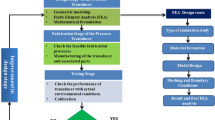Abstract
The equipment used in stress- and pressure-related non-destructive testing (NDT) experiments tends to have single functionality and a low degree of automation. There are also safety risks inherent in existing pressure testing methods. This paper develops a remote online NDT comprehensive experimental device. It uses a high degree of automation to remotely monitor changes in a pressure vessel’s prefabricated defects during pressure tests. Safety is guaranteed, as the operator is located remotely. The experimental pressure vessel employs a split structure connected by a quick-release system using flange-type U-slot bolt holes. Pressure vessel defects can be prefabricated in different forms, and the vessels can be disassembled and changed easily. This process reduces the experiment materials needed, lowers costs, and saves experimental time. The device can be used for various experiments, such as acoustic emission monitoring of the pressure-bearing and load-holding capacities of pressure vessels, measurement of pressurized vessel strain, and pressure vessel NDT (magnetic powder inspection, ultrasonic flaw detection, magnetic flux leakage testing, magnetic memory testing). Operators can obtain experimental data and conduct analyses simply by controlling the computer. The device can enrich the content of undergraduate experiments and solve the single-functionality problem of existing experimental equipment. With this device, the acoustic emission online monitoring experiment of pressure vessel and the stress measurement of pressure vessel are carried out. Which verify the diversity of function and reliability of the test.











Similar content being viewed by others
References
Silva, H., Sá, S., Brandão, L., et al. (2013). Gas solute movement in packed columns-A remote control experiment. Education for Chemical Engineers, 8(3), 94–104. https://doi.org/10.1016/j.ece.2013.06.002.
Dai, J. L., Liao, C. J., & Li, J. W. (2013). Application of industrial remote monitoring system in small experiment devices. Contemporary Chemical Industry, 42(3), 316–318. https://doi.org/10.13840/j.cnki.cn21-1457/tq.2013.03.008.
Ai, H. (2013). Function development and application of process control experimental device. Experimental Technology and Management, 30(8), 50–53. https://doi.org/10.16791/j.cnki.sjg.2013.08.014.
Staudt, V., Menzner, S., & Bauer, P. (2010). Remote-controlled experiment with integrated verification of learning outcome. Journal of Power Electronics, 10(6), 604–610.
Vogelsberger, M. A., Macheiner, P., Bauer, P., et al. (2010). Drives and motion control teaching based on distance laboratory and remote experiments. Journal of Power Electronics, 10(10), 579–586.
Lyons, J. S., Iyer, S. R., Lovering, R. M., et al. (2016). Novel multi-functional fluid flow device for studying cellular mechanotransduction. Journal of Biomechanics, 49(16), 4173–4179. https://doi.org/10.1016/j.jbiomech.2016.11.051.
Qin, X., Shi, Z., Xie, Y., et al. (2017). An integrated device with high performance multi-function generators and time-to-digital convertors. Review of Scientific Instruments, 88(1), 1–19. https://doi.org/10.1063/1.4973725.
Lin, M. J., Shu, X. L., Ma, H. H., et al. (2017). Application of remote control device in fire area blasting. Blasting, 34(1), 133–137. https://doi.org/10.3963/j.issn.1001-487X.2017.01.024.
Gu, M. F. (2012). Design calculation for a kind of quick-opening manhole flange. Sulphur Phosphorus and Bulk Materials Handling Related Engineering, 5, 8–10. https://doi.org/10.16341/j.cnki.spbmh.2012.05.004.
Shi, Z. M., & Gan, L. (2012). Stress and fatigue analysis of clamp connection structure of decompression chambers. Ship Science and Technology, 34(11), 75–81. https://doi.org/10.3404/j.issn.1672-7649.2012.11.017.
Tu, S. T., Chen, X., Song, X. G., et al. (2015). A fluid-structure interaction analysis of the spring-loaded pressure safety valve during popping off. Procedia Engineering, 130(12), 87–94. https://doi.org/10.1016/j.proeng.2015.12.178.
Li, J. L., Chen, L. Z., & Song, X. G. (2015). Multi-objective design optimization of a pressure safety valve for raped opening and reclosing. Procedia Engineering, 130(12), 113–124. https://doi.org/10.1016/j.proeng.2015.12.181.
Yang, X. D., Wang, Y., & Pan, X. (2012). Research on anti-jamming algorithm of serial communication in remote monitoring system. Microelectronics and Computer, 29(2), 78–80. https://doi.org/10.19304/j.cnki.issn1000-7180.2012.02.017.
Wang, Y. G., & Chen, W. Y. (2014). Design of water level automatic control system based on MCGS and PLC. Measurement and Control Technology, 33(1), 96–98. https://doi.org/10.3969/j.issn.1000-8829.2014.01.025.
Zhang, F., Wang, W., Qiu, Z. M., et al. (2015). Design of manipulator control system based on MCGS configuration software. Machine Tool and Hydraulics, 43(21), 23–27. https://doi.org/10.3969/j.issn.1001-3881.2015.21.005.
Shi, D., Lu, G. H., Sun, S. L., et al. (2016). Control system for screw chiller based on S7-200 PLC and MCGS. Journal of Mechanical and Electrical Engineering, 33(12), 1523–1528. https://doi.org/10.3969/j.issn.1001-4551.2016.12.020.
Acknowledgements
This work was sponsored by the National Natural Science Foundation of China (51607035, 11502051) and Heilongjiang Postdoctoral Foundation (LBH-Z16040) and State Administration of Work Safety Science and Technology Project of Key Technologies for Preventing and Controlling Major Accidents in Safe Production (heilongjiang-0003-2017AQ) and Science and Technology Project of China Petroleum and Chemical Industry Association (2017-11-04) and Research start-up fund of Northeast Petroleum University (rc201732). All these are gratefully appreciated.
Author information
Authors and Affiliations
Corresponding author
Rights and permissions
About this article
Cite this article
Cui, W., Wang, K., Zhang, P. et al. Design of a Comprehensive Pressure Vessel Experimental Device. Wireless Pers Commun 102, 783–798 (2018). https://doi.org/10.1007/s11277-017-5100-8
Published:
Issue Date:
DOI: https://doi.org/10.1007/s11277-017-5100-8




